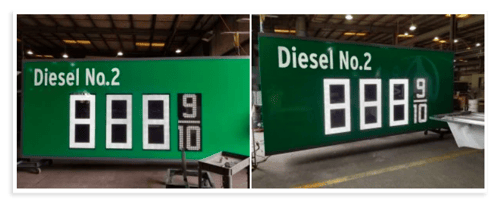
If you’re reading this article, chances are you have an entrepreneurial spirit and are interested in learning what it takes to open and operate a convenience store. Well, you’re in luck!
According to the U.S. Department of Transportation, there are over 272 million registered vehicles on roadways each day. Convenience stores provide the motoring public a place to refuel their vehicles and bodies when tank gauges get low, cravings for a sweet treat kick-in, or when mother nature calls. With the right location, inventory, merchandise, branding, and pricing, a convenience store can often be a lucrative business.
Throughout the U.S. there are nearly 162,000 convenience stores of which 58% are owned and operated by single-store operators whose total industry sales generated a whopping $650 billion in 2019. What does this mean to the entrepreneurial-minded person and how can you get a slice of the pie? The time is now and the opportunity to reach millions of people and build a thriving business is an enticing venture.
Like most things in life, weighing the pros and cons, developing a plan-of-action, and execution set a profitable business apart from one that struggles to break even. Here is a guide on how you can vie for your share of a market that continues to see rapid growth in consumer demand.
Do Your Homework
You might think developing a business plan would be your first step in the journey to become a convenience store entrepreneur; however, it’s important to begin by spending time studying the industry you plan to dominate. A lot has changed since Gulf Refining Company opened the first service station and began dispensing kerosene at an Indiana grocery store in the late 1880’s. Since then, U.S. oil companies have continued to shed retail assets as business models and motoring habits have evolved. This eb and flow has created times of consolidation and disbursement, ultimately resulting in opportunities for both small and large businesses.
The entire convenience store concept is predicated on the concept of providing fast and friendly service while being conveniently located. High visibility and ease of access increases the opportunity for foot traffic from local patrons to one-time travelers passing through the area on a road trip. Location in this sense, is everything for convenience stores.
Plan the Work, Work the Plan
The modern-day convenience store is driven by habits of the motoring public. As consumer demands have changed, so too have the convenience and fuel retailing industries. A well-developed business and marketing plan are what keeps convenience stores on track and ensures they are positioned to withstand what can often be a volatile segment of the oil and gas industry.
The first step is to decide which route best suits your goals. If marketing, advertising, and startup tasks are not your cup of tea, franchising might be the best route for you. While up front franchise fees can be costly, having the support often means a business is up and running faster. Instore merchandise, fuel brand, food offering, product placement, and store layout are a few of the restrictions that come with choosing to enter the industry as a franchisee.
If your cash position is well funded and you enjoy the work involved in building from the ground up, you might be better suited choosing to develop your own brand and leveraging your own creativity. While many consumers often flock towards what they know, just as many will continue their quest to support locally owned businesses that sell local goods.
Regardless of your goals and whether you decide to franchise or build from the ground up, your business and marketing plan should outline adequate funding sources, determine up front and ongoing maintenance costs, analyze market trends, and constantly adapt to customer behavior and demographics.
Show me the Money!
If you’re like most successful entrepreneurs, you know how to budget and leverage the power of cash vs loans to make wise investments. So, how do you pay for the convenience store of your dreams? To start, developing relationships with local banks is a great way to build a lasting relationship and secure quicker funding. In addition, the U.S. Small Business Administration offers a variety of loan solutions to help business owners get started. Another option is to look for investors to join you on your journey to becoming a convenience store entrepreneur. The NACS 2018 State of the Industry Report showed convenience stores averaging $4 million in gross sales revenue; however, as is typical with the food industry, profit margins are slim. Finding ways to reduce overhead costs and theft of product can attract the right investor who is hyper-focused on the bottom line and ROI.
Operating Costs, Staffing, and Vendor Relationships
Primary operating expenses for a convenience store include utilities and monthly building lease. Beyond that, the largest expenditure comes from inventory and labor.
The exact costs of all these expenses vary due to store size, diversity of inventory, location, and employee compensation. While paying employees more than your local minimum wage can put a strain on your budget, higher pay will likely result in better loyalty and performance, which translates to greater profit for you. Excellent customer service promotes customer loyalty and hiring and training the right people from the start can save you money, time, and stress down the road by ensuring you’re supported by employees who can execute your business vision.
Understanding your operating and employee needs are essential to any convenience store operation; however, just as important are the relationships you build with vendors. Luckily there are wholesale distributors who offer 30, 60, and 90-day financing options and allow for unused merchandise to be returned for credit towards future purchases, known as trade-back agreements. A word of caution when negotiating trade-back agreements with vendors, some may require you to purchase a larger volume of merchandise than the unsold volume you return. Choosing the right vendors will help you secure the equipment and tools necessary to do business, including store and inventory management software, point of sale hardware, financials, labor, and other business tasks. Establishing delivery schedules with product suppliers that do not interfere with the flow of business is another critical part of operating a convenience store.
Compliance & Insurance
Compliance, compliance, compliance! It cannot be stressed enough the importance for convenience retailers to maintain compliance with regulators and adhere to local ordinances. This task is easier said than done, particularly when you factor in that convenience stores are regulated in some states by over 30 federal, state, and local regulatory agencies. At the very least, you will need a sales and use license from the state department of taxation in order to collect sales tax on items sold. Other licenses, permits, and business requirements include, but are not limited to:
- Federal Tax ID
- Business License
- Resale Certificate
- Certificate of Occupancy
- Alcohol & Tobacco Sales
- Health Permit
- Zoning
- Signage
- Building Construction
- Environmental Permit
- Lottery License
Laws and regulations change frequently. A helpful list of state and federal licenses and permits can be found by visiting the U.S. Small Business Administration’s website.
In addition to the items listed above, proper insurance must be carried to protect your business from theft and claims. Most convenience stores operate 24/7 and serve nearly half of the U.S. population each day, making the chances for something to go wrong much more likely. Maintaining adequate insurance can save your business from a financially crippling claim in the event of a customer trips over a curb, slips in the bathroom, or causes a fire at the pump.
So, the question you must ask yourself is, do you have what it takes to get into the convenience retailing space? Are you prepared to entrench yourself in detail and compete with over 162,000 businesses across the United States? Better yet, are you willing to put in the work necessary to divert traffic from the convenience store down the road or across the street? If you’re answer to these questions is yes, then you are well on your way to becoming a successful convenience store entrepreneur.
Read more:
https://www.statista.com/statistics/183505/number-of-vehicles-in-the-united-states-since-1990/
https://www.convenience.org/Research/FactSheets/FuelSales
https://aoghs.org/transportation/first-gas-pump-and-service-stations/






